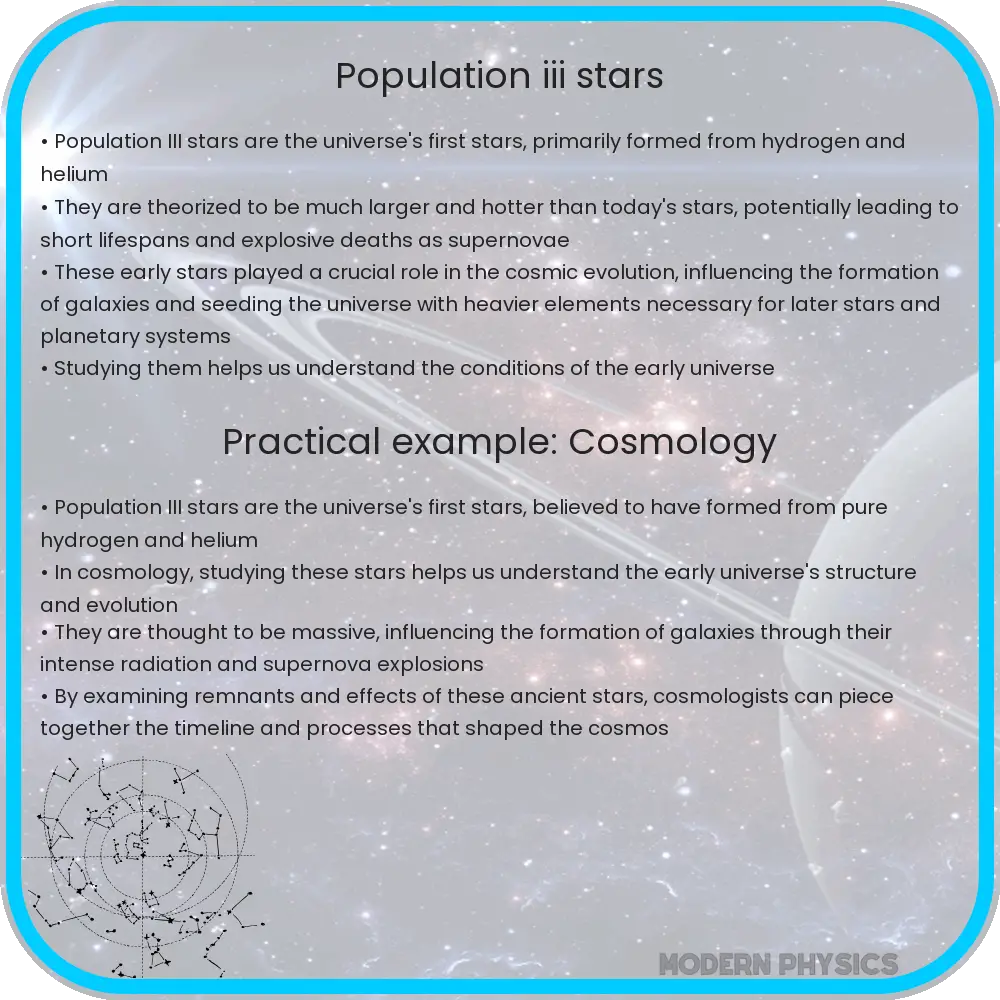Explore the mysteries of Population III stars, their origins, unique characteristics, and cosmic impact, shedding light on the early universe’s formation and evolution.

Origin of Population III Stars
Population III stars, also known as the first stars, are theorized to be the earliest generation of stars in the universe, formed approximately 100 million years after the Big Bang. Unlike later generations, these stars were created from a primordial mix of hydrogen and helium, with virtually no heavier elements, referred to as ‘metals’ in astronomical terms. This absence of metals, due to the lack of previous star generations to synthesize them, is a defining characteristic of Population III stars.
The formation of these ancient stars marked a pivotal moment in cosmic history, initiating the reionization period. This era witnessed the transformation of the universe from a state of darkness, known as the ‘cosmic dark ages’, into one filled with light and transparent gas. The mechanisms behind the formation of Population III stars are still under investigation, with theories suggesting that the process was influenced by dark matter halos, providing the necessary gravitational pull for gas to accumulate and eventually ignite into stars.
Characteristics of Population III Stars
Population III stars are believed to have been significantly different from the stars we observe today. Their pure composition led to distinct physical characteristics. The absence of metals meant that these stars had fewer ways to cool down, resulting in larger, hotter, and more massive stars compared to subsequent generations. Estimates suggest that Population III stars could have been hundreds, or even thousands, of times more massive than the Sun, shining brightly with intense ultraviolet light that played a crucial role in altering the state of the universe.
Another significant difference lies in their lifespan. Due to their massive size, Population III stars were likely short-lived, burning through their nuclear fuel at a rapid pace. This brief existence culminated in explosive endings, either as supernovae or as direct collapses into black holes, events that were fundamental in dispersing heavier elements into the cosmos, seeding the universe with the building blocks necessary for the formation of stars and galaxies that we see today.
The exact characteristics of Population III stars, including their initial mass function and the specifics of their formation processes, remain areas of active research. However, their role in shaping the early universe is undeniable, marking the beginning of cosmic structure and the distribution of elements necessary for life as we know it.
Population III Stars: Cosmic Ancestors
Population III stars are the universe’s first-born stars, emerging from the primordial darkness mere millions of years after the Big Bang. These stars have significantly influenced cosmic history, laying the foundation for the complex structures we observe today. Unlike their successors, Population III stars contained no metals, a term astronomers use to describe elements heavier than helium. This primordial composition influenced their size, lifespan, and legacy.
Characteristics and Formation
Population III stars were composed almost entirely of hydrogen and helium, with trace amounts of lithium. This composition is a stark contrast to later generations of stars, which contain heavier elements from previous supernovae. The absence of metals meant these stars lacked the cooling mechanisms present in later generations, allowing them to grow to massive sizes, often hundreds of times the mass of our Sun. These giants burned hot and fast, living for only a few million years before meeting explosive ends.
Impact on the Cosmos
The death of Population III stars was monumental. Their supernovae seeded the universe with the first heavy elements, such as carbon, oxygen, and iron. This process, known as nucleosynthesis, was crucial for the development of subsequent generations of stars, planets, and ultimately life itself. The remnants of these first stars also contributed to the reionization of the universe, a process that ended the cosmic dark ages and made the universe transparent to light.
Conclusion
The legacy of Population III stars is profound. Without them, the chemical richness required for life as we know it would not exist. Their massive supernovae dispersed the elements necessary for the formation of galaxies, stars, and planets. Despite their brief existence, these celestial titans shaped the structure and composition of the universe. Today, astronomers seek to observe these elusive stars through next-generation telescopes, aiming to understand more about our cosmic origins and the nature of the early universe. The study of Population III stars is not just a journey into the past; it’s a quest to understand the very fabric of our universe.
